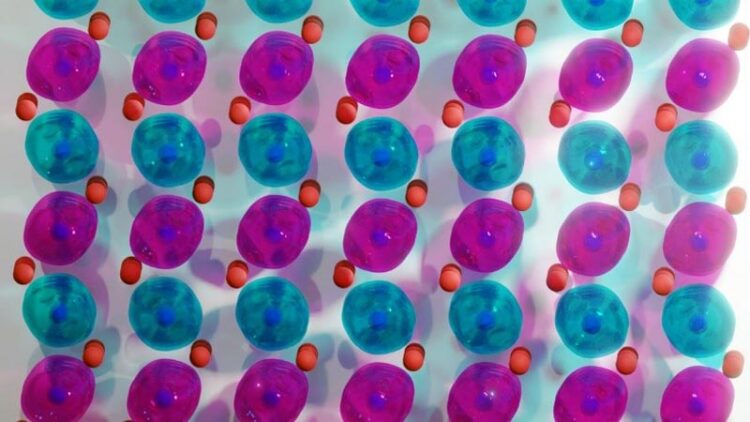Good prospects for altermagnets in spin-based electronics

The crystal structure of altermagnetic CrSb: the colored bubbles around the Cr atoms (blue) correspond to iso-spin density surfaces. Their anisotropy enables spin polarized currents.
ill./©: Libor Šmejkal and Anna Birk Hellenes / JGU
Altermagnetic CrSb with promising characteristics for electronic applications.
Altermagnets represent a newly recognized class of materials in magnetism that could enable novel applications in spin-based electronics. Their magnetically ordered state consists of an antiparallel arrangement of microscopic magnetic moments, so-called spins, as in antiferromagnets. In contrast to antiferromagnetism, however, the altermagnetic state with zero net-magnetization enables the generation of electrical currents with spin polarization, as required in spin-based electronics. Thus, altermagnets combine the advantages of antiferromagnets, i.e., ultrafast dynamics, and ferromagnets, i.e., large spin polarization.
In collaboration with a theoretical team led by Professor Jairo Sinova and Dr. Libor Šmejkal, experimental physicist Dr. Sonka Reimers and her colleagues in Professor Mathias Kläui’s lab at the Institute of Physics at Johannes Gutenberg University Mainz (JGU) have demonstrated altermagnetic electronic band splitting associated with spin polarization in CrSb. “The magnitude of this spitting, observed in a good conductor and at room temperature, is extraordinary and promising with regard to electronic applications of altermagnetic materials”, said Professor Martin Jourdan, coordinator of the study recently published in Nature Communications.
Image:
https://download.uni-mainz.de/presse/08_physik_komet_altermagnetismus_crsb.jpg
The crystal structure of altermagnetic CrSb: the colored bubbles around the Cr atoms (blue) correspond to iso-spin density surfaces. Their anisotropy enables spin polarized currents.
ill./©: Libor Šmejkal and Anna Birk Hellenes / JGU
Related links:
• https://www.klaeui-lab.physik.uni-mainz.de/ – Kläui Lab at the JGU Institute of Physics
• https://www.blogs.uni-mainz.de/fb08-iph-eng/ – JGU Institute of Physics
Read more:
• https://press.uni-mainz.de/scientists-directly-observed-altermagnetism/ – press release “Scientists directly observed altermagnetism” (19 Feb. 2024)
• https://press.uni-mainz.de/altermagnetism-experimentally-demonstrated/ – press release “Altermagnetism experimentally demonstrated” (15 Feb. 2024)
• https://press.uni-mainz.de/efficient-read-out-in-antiferromagnetic-spintronics/ – press release “Efficient read-out in antiferromagnetic spintronics” (25 Nov. 2021)
• https://press.uni-mainz.de/detecting-damage-in-non-magnetic-steel-with-the-help-… – press release “Detecting damage in non-magnetic steel with the help of magnetism” (24 July 2018)
• https://press.uni-mainz.de/antiferromagnets-prove-their-potential-for-spin-based… – press release “Antiferromagnets prove their potential for spin-based information technology” (29 Jan. 2018)
Wissenschaftliche Ansprechpartner:
Professor Dr. Martin Jourdan
Condensed Matter Physics
Institute of Physics
Johannes Gutenberg University Mainz
55099 Mainz, GERMANY
phone: +49 6131 39-23635
e-mail: jourdan@uni-mainz.de
https://www.klaeui-lab.physik.uni-mainz.de/martin-jourdan/
Originalpublikation:
S. Reimers et al., Direct observation of altermagnetic band splitting in CrSb thin films, Nature Communications, 8 March 2024,
DOI: 10.1038/s41467-024-46476-5
https://www.nature.com/articles/s41467-024-46476-5
Media Contact
All latest news from the category: Power and Electrical Engineering
This topic covers issues related to energy generation, conversion, transportation and consumption and how the industry is addressing the challenge of energy efficiency in general.
innovations-report provides in-depth and informative reports and articles on subjects ranging from wind energy, fuel cell technology, solar energy, geothermal energy, petroleum, gas, nuclear engineering, alternative energy and energy efficiency to fusion, hydrogen and superconductor technologies.
Newest articles

Recovering phosphorus from sewage sludge ash
Chemical and heat treatment of sewage sludge can recover phosphorus in a process that could help address the problem of diminishing supplies of phosphorus ores. Valuable supplies of phosphorus could…

Efficient, sustainable and cost-effective hybrid energy storage system for modern power grids
EU project HyFlow: Over three years of research, the consortium of the EU project HyFlow has successfully developed a highly efficient, sustainable, and cost-effective hybrid energy storage system (HESS) that…

After 25 years, researchers uncover genetic cause of rare neurological disease
Some families call it a trial of faith. Others just call it a curse. The progressive neurological disease known as spinocerebellar ataxia 4 (SCA4) is a rare condition, but its…





















